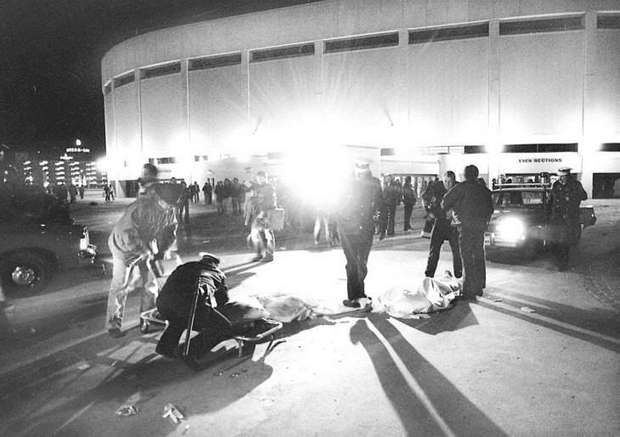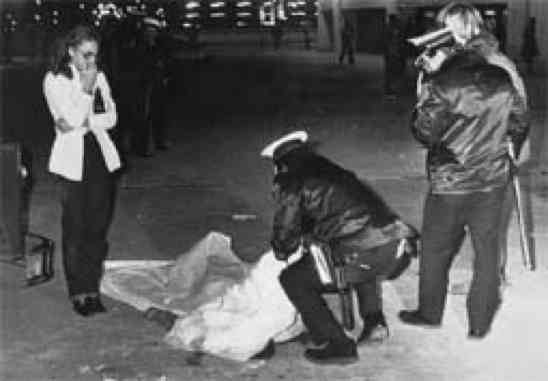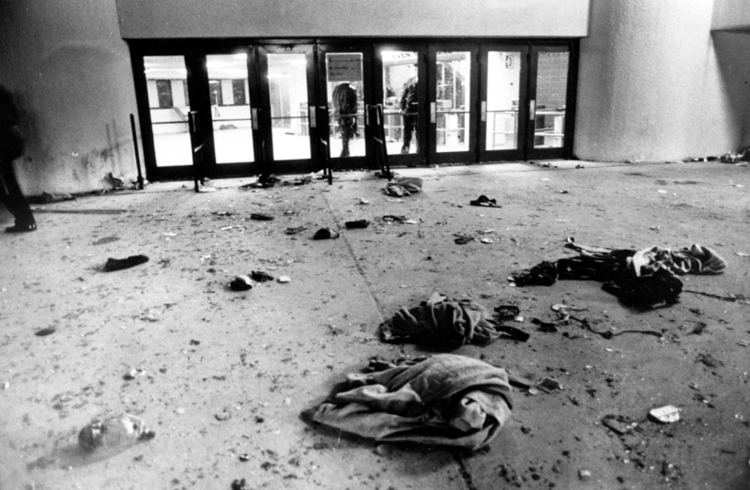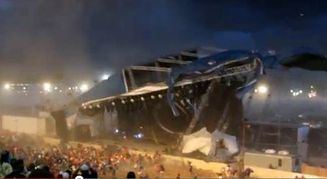Non-fatal injuries 26 Total number of deaths 11 Location U.S. Bank Arena | Date 3 December 1979 Injuries 26 | |
 | ||
Similar Burnden Park disaster, 1994 Gowari stampede, Ellis Park Stadium disaster, Accra Sports Stadium, Luzhniki disaster | ||
The who concert cincinnati december 3 1979
The Who concert disaster occurred on December 3, 1979 when British rock band the Who performed at Riverfront Coliseum in Cincinnati, Ohio, United States, and a stampede of concert-goers outside the coliseum's entry doors resulted in the deaths of eleven people.
Contents

Background

The Who were in the midst of the United States portion of their 1979 world tour and had already played Passaic, New Jersey, New York City, Detroit, and Pittsburgh before arriving in Cincinnati. The concert was a sellout, with 18,348 tickets sold. The majority of these, 14,770, were unassigned general admission tickets that were first-come, first-served.

A few hours before the show, a sizeable crowd had already gathered at the front of the arena. Entry to the arena was through a series of individual doors all along the front of the arena, as well as a few doors at each side. The crowd focused at each of the doors. The doors were not opened at the scheduled time, causing the crowd to become increasingly agitated and impatient. During this period, the Who undertook a late soundcheck. Some members of the crowd heard this and mistakenly believed that the concert was starting. Some people in the back of the crowd began pushing toward the front, but this rush soon dissipated as the crowd realized that no doors had been opened and that the concert had not begun.
The stampede

A pair of doors were finally opened at the far right of the main entrance. As concert goers entered the stadium through the two open doors, those waiting in front of all of the other doors began pushing forward. After a short period of waiting and then knocking on the doors and the glass next to the doors, the crowd realized that none of the remaining doors would be opened. The entire crowd then surged and pushed toward the two doors which had been opened. This caused many people to get trampled while some suffered more serious injuries. Eleven people were unable to escape the crowd pushing toward them and died by asphyxiation. Twenty-six other people reported injuries.
The concert went on as planned, with the band members not told of the tragedy until after their performance. The following night a lengthy segment on the tragedy aired on the CBS Evening News with Walter Cronkite examining violence at rock concerts. Guitarist Pete Townshend was interviewed by CBS News correspondent Martha Teichner comparing crowd reactions at concerts to football and boxing matches calling them "high energy events."
Aftermath

In Providence, Rhode Island, mayor Vincent A. Cianci cancelled a scheduled performance of the Who at the city's Civic Center that same month. This was despite the fact that the Providence venue had assigned seating. 33 years later, the band returned to Providence and honored tickets from the 1979 show.
The families of the victims sued the band, concert promoter Electric Factory Concerts, and the city of Cincinnati. The suits were settled in 1983, awarding each of the families of the deceased approximately $150,000 ($360,700 today), and approximately $750,000 ($1,803,500 today) to be divided among the 23 injured. The city of Cincinnati also imposed a ban on unassigned seating on December 27, 1979, with minor exceptions, for the next 25 years.
The incident was the subject of a book, Are The Kids All Right? The Rock Generation And Its Hidden Death Wish, as well as a second-season episode of WKRP in Cincinnati called "In Concert". It also inspired scenes in the film Pink Floyd—The Wall, whose 1982 premiere was attended by the Who's Pete Townshend.
In 2004, the city of Cincinnati permanently repealed its long-standing ban on unassigned seating, a move which has been criticized by some. The goal of lifting the ban was to attract more big-name acts. However, the city now mandates there must be nine square feet per person at a venue, and the number of tickets sold for each event is adjusted accordingly.
Paul Wertheimer, the city's first Public Information Officer at the time of the tragedy, went on to serve on a task force on crowd control, and later founded Crowd Management Strategies in 1992, a consulting firm based in Los Angeles.
In 2009, thirty years after the tragedy, rock station WEBN/102.7 aired a retrospective on the event, including clips from news coverage in 1979.
In 2014, Pearl Jam played in the city and acknowledged the tragedy. They dedicated a cover of the Who's "The Real Me" to those who died. In 2000, Pearl Jam experienced a similar tragedy, when 9 people died at Roskilde Festival during their concert.
On the eve of the 35th anniversary of the tragedy, Cincinnati Mayor John Cranley promised to have a historical marker on the site of the tragedy in 2015. The marker was dedicated at U. S. Bank Arena on December 3, 2015.
The Showtime series Roadies dedicated an entire episode to the '79 event. The episode, "The City Whose Name Must Not Be Spoken", showcases the "roadies" of a fictional band completing many rituals after someone on the tour bus mentions Cincinnati.
